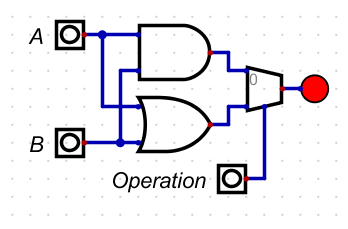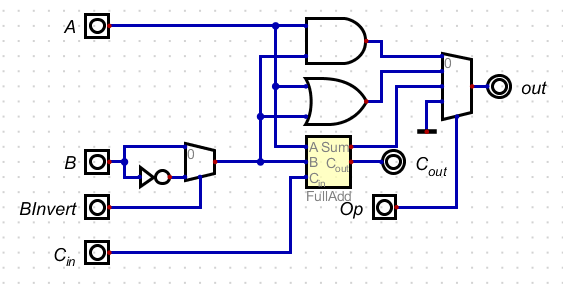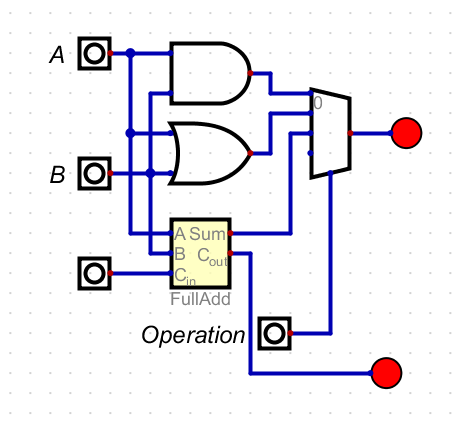$\require{cancel}$
Building an ALU
- This is section B.5 page 716
- They assume we have done a better job of looking at the instruction set so:
- Go to the green card.
- Look at the CORE instruction set
- This is not the full instruction set, but it is represetative of the instruction set.
- The full set is in A.10 (I think)
- This is also only integer.
- What MATH instructions do you see
- Add*
- OR, NOR, AND
- Subtract*
- Could these use the ALU?
- Branch on *
- Set Less Than *
- It looks to me like we will problably need an ALU to do all of these.
- We are not going to do chapter 3.
- it is fantastic, but we don't have time.
- It covers multiply, divide and floating point.
- I like the development of the ALU. It is resonably gentle.
- First they develop a one bit AND/OR unit
- This has two input bits and produces an and or an or of these.
- And it has a control line to select which is produced.
-

- Next let's develop a full adder.
- This circuit takes two input bits and a carry in.
- It produces the sum and a carry out.
- Build the table
- Build the expressions
- Build as a New Embedded circuit.
-

- We can then add this to our 1 bit ALU
- Here is a four bit version of an ALU (at least at this midpoint)
-

- The next step is to support subtraction.
- This would be a-b
- This is quite easy as all we need to do is invert b and add 1
- We can use the carry in to add 1.
- And modify the one bit alu
- Add a control line for binvert
- Use this to drive a mux to select between $b$ and $\overline{b}$.
-

- They state that we need a
nor for mips.
- $\overline{a+b} = \overline{a} \overline{b}$
- So we can add an a invert, and an a invert line to accomplish this.
- They also add a less line.
- This is for
slt
- An R type instruction
- R[rd] = 1 if (R[rs] < R[[rt]]) otherwise 0
- To do this, we are going to compute a-b
- If it is a negative number, we will set the output to be 1
- If it is a positive or 0 number, we will not.
- So the
less line will allow us to carry the "sign" bit from the last 1-bit ALU back to the first 1-bit ALU.
- And this will be output 3 from the control
| Control Bits | Ainvert | Binvert | Operation |
|---|
| 00 | 0 | 0 | and |
| 00 | 1 | 1 | nor |
| 01 | 0 | 0 | or |
| 10 | 0 | 0 | a+b |
| 10 | 0 | 1 | a-b |
| 11 | 0 | 1 | slt |
- The last bit is for
beq
- If the two registers are equal, increment the pc by the immediate.
- This can be done with a subtraction.
- If all bits are 0, the numbers are the same.
- So we will have the ALU do a-b, and an or of all of the resulting bits.


